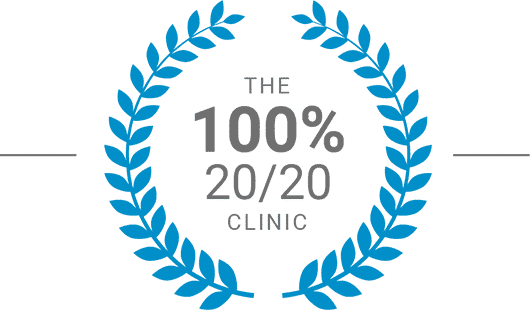Book Your Free Consultation
Mr David Allamby
MD, FRCOphth, FRCS
If you’re tired of glasses and contacts, but don’t meet the requirements for LASIK, implantable contact lens surgery (ICL) could be the solution you've been looking for.
This cutting-edge procedure offers a permanent alternative to traditional lenses and glasses, allowing you to see clearly without hassle.
But what can you expect after the surgery?
Let’s explore recovery, potential side effects, and tips for maintaining clear vision after ICL surgery.
Immediately after ICL surgery, you’re likely to experience slight discomfort, bloodshot eyes, and blurry vision for a short time, from a few hours up to 48 hours. You can expect checkups, around four weeks of healing time, the need to wear an eye shield, and regular use of special eye drops while your eye heals.
After the surgery, your eye will be covered with a shield to reduce the sensitivity to light and prevent you from rubbing your eye or putting pressure on it in your sleep. Your doctor will instruct you whether you should wear the eye cover all day and night and how long you need to wear it.
You’ll go for a checkup the day after the ICL procedure to ensure that everything is healing as expected and to ensure there are no eye pressure problems.
You'll be prescribed special eye drops that you'll need to use every day for a few weeks to prevent inflammation and infection. You might also need antibiotics or a steroid for healing.
You should expect discomfort and bloodshot eyes after surgery. Your vision will be blurry after ICL, but it will gradually improve as your eyesight continues to heal.
During the healing process, it's normal to experience vision fluctuations, and your eye may feel gritty and uncomfortable for the first few days. Still, it will usually pass after the first week.
Most patients are said to have driving-standard vision after the first 24 hours, and after three or four weeks, final healing results should show, and you can experience the joy of glasses-free sharp eyes.
All in all, it’ll take around four weeks to recover fully and see the complete results.
Although ICL has a total healing time of around four weeks, your vision will gradually improve over six months.
You'll have a couple of aftercare appointments so the ophthalmologist or optometrist can evaluate the progress and healing. Typically, after your first checkup, you'll return for another visit within ten days, then four weeks, and then three to six months later.
After completing your ICL checkups, you'll need a checkup once a year to ensure your eye remains healthy. Annual eye exams ensure your eyesight remains intact and helps doctors notice if any complications need attention.
You won't ever feel the ICL in your eye after it's healed because it is attached and maintenance-free, and the lens will not wear out. Once your eye has fully healed, you’ll be able to open your eyes underwater without any issues.
Since your eyes are delicate, you should visit your doctor if you experience visual impairments after ICL.
You should call your doctor if you experience eye pain at any stage, eye swelling, eye stickiness, and worsened vision.
Other severe impairments to look out for are if lights look flashy or strobed and if you see floating or blank spots, which can be a symptom of retinal detachment, a severe problem.
Other eye problems can cause you to have headaches that feel like sinus headaches paired with nausea.
Clinical studies show excellent ICL success rates, as 98% of patients experience ICL as effective, similar to LASIK.
A further survey showed that vision improvement and ICL surgery satisfaction reached 99.9%, so you're almost guaranteed a better quality of vision.
Like any surgery, there are precautions to adhere to after the procedure for your safety and well-being.
You should follow your doctor's instructions regarding your eye shield and taking your prescribed eye drops. Remember to wash your hands before using eye drops to prevent infection.
Take it easy for the first 24 hours after ICL, watch where you walk and don't drive until your doctor says it is okay. Keep your eye shield while showering for the first few days to prevent anything from getting into your eye.
You should avoid rubbing your eyes or putting cream or eye makeup on them for the first two weeks, and you should avoid exercising and swimming for the first two weeks after surgery.
It’s also recommended to wear UV-protection sunglasses when in the sun, especially for the first week after the procedure.
ICL is highly successful, but there are always risks involved with any surgery. Find out more about the risks and safety of ICL.
The prime concern at the beginning of the healing process is an eye infection, but if you follow your doctor's instructions, you shouldn't have any issues.
There are potential long-term problems that an ICL patient can run into, which is why checkups are so important, but you can expect a smooth ICL journey if you keep tabs on your visual health and see your doctor yearly.
Although ICL complications are rare, it is best to be aware of them before surgery. These are some of the most common complications from the procedure:
Halos are glaring that shine around lights when you look at them, and starburst is when you see rays of light that emanate from a light source.
Halos and starbursts are mostly experienced at night and can be annoying — some experience them worse than others.
These light refractions are normal during the ICL healing process but sometimes remain problematic after healing.
Permanent halos and starbursts are eliminated by removing the ICL or pairing the ICL with LASIK. After healing, those with halos and starbursts usually have clear vision and live with the issue to keep the benefits of the ICL.
If your ICL was for short-sightedness and remains an issue after you've healed, your ICL might be under-corrected.
Your vision may have improved, but it still isn’t perfect.
Depending on the severity of the issue, patients may leave it if they're still satisfied with the improvement or need to undergo an enhancement procedure.
ICL overcorrection means that your vision has been changed to being slightly long-sighted, which can impact your close vision. Depending on the severity, your doctor may offer you an enhancement procedure, including LASIK.
Eye pressure increase is standard after ICL and will decrease as it heals, which is the main reason for clinic checkups.
Eye pressure prevents fluid from flowing from the back of the eye to the front, causing it to ache.
One of the reasons for this occurrence is that your ICL is too big, and the doctor will need to replace it with a smaller one. There is no charge to replace your ICL in this situation.
Presbyopia is a natural process where your eyes lose elasticity, gradually decreasing your close-up vision as you age.
This impairment usually occurs from the age of forty onwards. Although ICL doesn't cause presbyopia, it can reveal it more quickly, mainly if you use glasses instead of contact lenses.
If you underwent your ICL procedure to improve distant eyesight and have reached middle age, the far vision would remain clear, but you'll need glasses for reading and seeing near you because of presbyopia. Please note that presbyopia is normal for all middle-aged people.
Cataracts are when your vision becomes cloudy because proteins change in your eye, causing the lens to blur.
This vision damage occurs naturally with old age at around 60 years old, but studies have shown that early ICL models could cause the early onset of cataracts. It is much rarer with modern ICLs.
Even though cataracts are a natural sign of ageing, it helps to be aware that you might experience it sooner due to ICL.
Cataracts require surgery where your lens gets replaced with an artificial one, which means the ICL will also need removal.
After ICL surgery, you can expect it to take four weeks for your eyes to heal properly.
During the healing process, your vision will gradually increase, but you may experience mild discomfort. You'll need to wear an eye shield and use eyedrops as your doctor prescribes.
You should expect checkups within the first six months and then once annually. If you experience any abnormalities, you should visit your doctor as soon as possible.
You may encounter a few problems with ICL, but they are very rare.
If you’re considering ICL surgery or aren’t sure which procedure would be best for your prescription, schedule your free telephone consultation, and a member of our team will be happy to discuss your options and explain exactly what ICL surgery is.
Book a FREE* Consultation
To get a better idea of how we can help you, and also the different types of services we offer, book a consultation now.

100% 20/20 vision
Focus Clinic has a remarkable 100% success rate for 20/20 vision. We know of no other clinic that has matched these results. There is a big difference between, for example, 98% and 100% success, especially if you are in the 2%.

10 year guarantee
Your 10 Year Guarantee means you can return at any time if you have additional questions on the quality of your vision. If you have distance vision correction for short-sight then any repeat laser eye treatments to correct a return of myopia in the first 10 years are included free of charge.*

Most trusted eye treatment clinic
We have the highest trust rating of any ‘eye treatment’ rated clinic, according to independent review site TrustPilot. With an outstanding 9.9 out of 10, when it comes to your eyes, choose the clinic that actual patients trust the most.
*Terms and conditions apply, excludes any age-related changes and conditions unrelated to the primary treatment